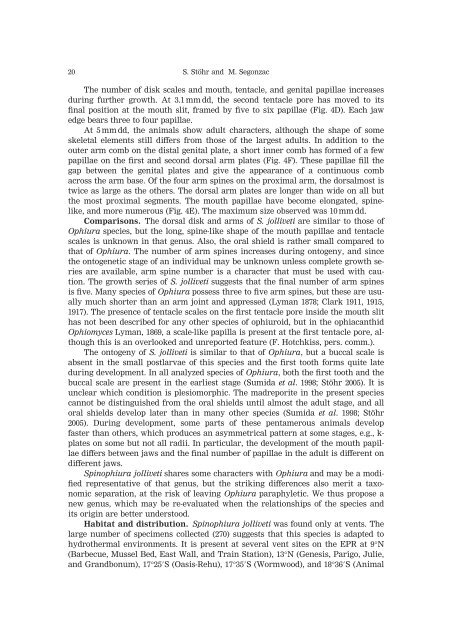from Hydrothermal Vents in the East Pacific - Station Biologique de ...
from Hydrothermal Vents in the East Pacific - Station Biologique de ...
from Hydrothermal Vents in the East Pacific - Station Biologique de ...
You also want an ePaper? Increase the reach of your titles
YUMPU automatically turns print PDFs into web optimized ePapers that Google loves.
20 S. Stöhr and M. Segonzac<br />
The number of disk scales and mouth, tentacle, and genital papillae <strong>in</strong>creases<br />
dur<strong>in</strong>g fur<strong>the</strong>r growth. At 3.1 mm dd, <strong>the</strong> second tentacle pore has moved to its<br />
f<strong>in</strong>al position at <strong>the</strong> mouth slit, framed by five to six papillae (Fig. 4D). Each jaw<br />
edge bears three to four papillae.<br />
At 5mmdd, <strong>the</strong> animals show adult characters, although <strong>the</strong> shape of some<br />
skeletal elements still differs <strong>from</strong> those of <strong>the</strong> largest adults. In addition to <strong>the</strong><br />
outer arm comb on <strong>the</strong> distal genital plate, a short <strong>in</strong>ner comb has formed of a few<br />
papillae on <strong>the</strong> first and second dorsal arm plates (Fig. 4F). These papillae fill <strong>the</strong><br />
gap between <strong>the</strong> genital plates and give <strong>the</strong> appearance of a cont<strong>in</strong>uous comb<br />
across <strong>the</strong> arm base. Of <strong>the</strong> four arm sp<strong>in</strong>es on <strong>the</strong> proximal arm, <strong>the</strong> dorsalmost is<br />
twice as large as <strong>the</strong> o<strong>the</strong>rs. The dorsal arm plates are longer than wi<strong>de</strong> on all but<br />
<strong>the</strong> most proximal segments. The mouth papillae have become elongated, sp<strong>in</strong>elike,<br />
and more numerous (Fig. 4E). The maximum size observed was 10 mm dd.<br />
Comparisons. The dorsal disk and arms of S. jolliveti are similar to those of<br />
Ophiura species, but <strong>the</strong> long, sp<strong>in</strong>e-like shape of <strong>the</strong> mouth papillae and tentacle<br />
scales is unknown <strong>in</strong> that genus. Also, <strong>the</strong> oral shield is ra<strong>the</strong>r small compared to<br />
that of Ophiura. The number of arm sp<strong>in</strong>es <strong>in</strong>creases dur<strong>in</strong>g ontogeny, and s<strong>in</strong>ce<br />
<strong>the</strong> ontogenetic stage of an <strong>in</strong>dividual may be unknown unless complete growth series<br />
are available, arm sp<strong>in</strong>e number is a character that must be used with caution.<br />
The growth series of S. jolliveti suggests that <strong>the</strong> f<strong>in</strong>al number of arm sp<strong>in</strong>es<br />
is five. Many species of Ophiura possess three to five arm sp<strong>in</strong>es, but <strong>the</strong>se are usually<br />
much shorter than an arm jo<strong>in</strong>t and appressed (Lyman 1878; Clark 1911, 1915,<br />
1917). The presence of tentacle scales on <strong>the</strong> first tentacle pore <strong>in</strong>si<strong>de</strong> <strong>the</strong> mouth slit<br />
has not been <strong>de</strong>scribed for any o<strong>the</strong>r species of ophiuroid, but <strong>in</strong> <strong>the</strong> ophiacanthid<br />
Ophiomyces Lyman, 1869, a scale-like papilla is present at <strong>the</strong> first tentacle pore, although<br />
this is an overlooked and unreported feature (F. Hotchkiss, pers. comm.).<br />
The ontogeny of S. jolliveti is similar to that of Ophiura, but a buccal scale is<br />
absent <strong>in</strong> <strong>the</strong> small postlarvae of this species and <strong>the</strong> first tooth forms quite late<br />
dur<strong>in</strong>g <strong>de</strong>velopment. In all analyzed species of Ophiura, both <strong>the</strong> first tooth and <strong>the</strong><br />
buccal scale are present <strong>in</strong> <strong>the</strong> earliest stage (Sumida et al. 1998; Stöhr 2005). It is<br />
unclear which condition is plesiomorphic. The madreporite <strong>in</strong> <strong>the</strong> present species<br />
cannot be dist<strong>in</strong>guished <strong>from</strong> <strong>the</strong> oral shields until almost <strong>the</strong> adult stage, and all<br />
oral shields <strong>de</strong>velop later than <strong>in</strong> many o<strong>the</strong>r species (Sumida et al. 1998; Stöhr<br />
2005). Dur<strong>in</strong>g <strong>de</strong>velopment, some parts of <strong>the</strong>se pentamerous animals <strong>de</strong>velop<br />
faster than o<strong>the</strong>rs, which produces an asymmetrical pattern at some stages, e.g., k-<br />
plates on some but not all radii. In particular, <strong>the</strong> <strong>de</strong>velopment of <strong>the</strong> mouth papillae<br />
differs between jaws and <strong>the</strong> f<strong>in</strong>al number of papillae <strong>in</strong> <strong>the</strong> adult is different on<br />
different jaws.<br />
Sp<strong>in</strong>ophiura jolliveti shares some characters with Ophiura and may be a modified<br />
representative of that genus, but <strong>the</strong> strik<strong>in</strong>g differences also merit a taxonomic<br />
separation, at <strong>the</strong> risk of leav<strong>in</strong>g Ophiura paraphyletic. We thus propose a<br />
new genus, which may be re-evaluated when <strong>the</strong> relationships of <strong>the</strong> species and<br />
its orig<strong>in</strong> are better un<strong>de</strong>rstood.<br />
Habitat and distribution. Sp<strong>in</strong>ophiura jolliveti was found only at vents. The<br />
large number of specimens collected (270) suggests that this species is adapted to<br />
hydro<strong>the</strong>rmal environments. It is present at several vent sites on <strong>the</strong> EPR at 9°N<br />
(Barbecue, Mussel Bed, <strong>East</strong> Wall, and Tra<strong>in</strong> <strong>Station</strong>), 13°N (Genesis, Parigo, Julie,<br />
and Grandbonum), 17°25S (Oasis-Rehu), 17°35S (Wormwood), and 18°36S (Animal
















